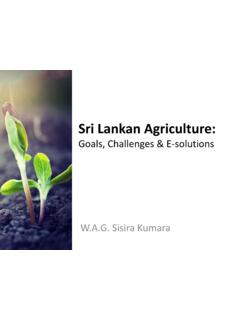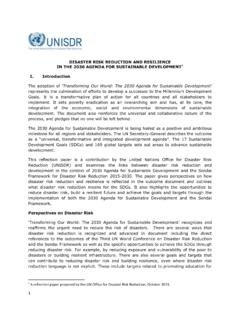Transcription of Climate-smart agriculture case studies 2021
1 Climate-smartagricultureProjects from around the worldcase studies 2021 Climate-smart agriculturecase studies 2021 Projects from around the worldFood and agriculture Organization of the United Nations Rome, 20214 Required citation: FAO. 2021. Climate-smart agriculture case studies 2021 Projects from around the world. Rome. The designations employed and the presentation of material in this information product do not imply the expression of any opinion whatsoever on the part of the food and agriculture Organization of the United Nations (FAO) concerning the legal or development status of any country, territory, city or area or of its authorities, or concerning the delimitation of its frontiers or boundaries. The mention of specific companies or products of manufacturers, whether or not these have been patented, does not imply that these have been endorsed or recommended by FAO in preference to others of a similar nature that are not views expressed in this information product are those of the author(s) and do not necessarily reflect the views or policies of FAO.
2 ISBN 978-92-5-134616-7 FAO, 2021 Some rights reserved. This work is made available under the Creative Commons Attribution-NonCommercial-ShareAlike IGO licence (CC BY-NC-SA IGO; ). Under the terms of this licence, this work may be copied, redistributed and adapted for non-commercial purposes, provided that the work is appropriately cited. In any use of this work, there should be no suggestion that FAO endorses any specific organization, products or services. The use of the FAO logo is not permitted. If the work is adapted, then it must be licensed under the same or equivalent Creative Commons licence. If a translation of this work is created, it must include the following disclaimer along with the required citation: This translation was not created by the food and agriculture Organization of the United Nations (FAO).
3 FAO is not responsible for the content or accuracy of this translation. The original [Language] edition shall be the authoritative edition. Disputes arising under the licence that cannot be settled amicably will be resolved by mediation and arbitration as described in Article 8 of the licence except as otherwise provided herein. The applicable mediation rules will be the mediation rules of the World Intellectual Property Organization and any arbitration will be conducted in accordance with the Arbitration Rules of the United Nations Commission on International Trade Law (UNCITRAL).Third-party materials. Users wishing to reuse material from this work that is attributed to a third party, such as tables, figures or images, are responsible for determining whether permission is needed for that reuse and for obtaining permission from the copyright holder.
4 The risk of claims resulting from infringement of any third-party-owned component in the work rests solely with the , rights and licensing. FAO information products are available on the FAO website ( ) and can be purchased through Requests for commercial use should be submitted via: Queries regarding rights and licensing should be submitted to: iiAcronyms iiiExecutive summary vIntroduction 1 Regional overview 4 ACTION POINT 1 EXPANDING THE EVIDENCE BASE 6 Introduction to expanding the evidence base 7 Mali complementing agricultural policies through the Climate-smart agriculture
5 Investment Plan 8 Sri Lanka working together to scale up Climate-smart crop systems 11 Senegal enhancing CSA learning by understanding indigenous knowledge and perceptions of climate change 14 Somalia mapping Climate-smart agricultural practices of rural women 17 Africa and the Near East using remote sensing to monitor water productivity 20 ACTION POINT 2 - SUPPORTING ENABLING POLICY FRAMEWORKS 24 Introduction to supporting enabling policy frameworks 25 Italy working with stakeholders in European Innovation Partnership Operational Groups to create Climate-smart innovations in Emilia-Romagna 26 Moldova promoting conservation agriculture through policy engagement and capacity building for smallholder farmers 28 African Region helping implement and coordinate policies with CSA country profiles 31 ACTION POINT 3 STRENGTHENING NATIONAL AND LOCAL INSTITUTIONS 36 Introduction to strengthening national and local institutions 37 Cambodia and Mongolia strengthening capacities in the agriculture .
6 Forestry and other land use sectors to improve the monitoring of and reporting on progress towards NDCs 38 Ghana developing training capacity for Climate-smart agriculture in cocoa 41 Botswana integrating traditional practices for CSA into crop and livestock production systems 44 ACTION POINT 4 ENHANCING FUNDING AND FINANCING OPTIONS 48 Introduction to enhancing funding and financing options 49 Global the Sustainable Rice Landscape Initiative: attracting funding and financing to scale up sustainable rice production 50 Switzerland piloting a goal-oriented farmer payment system for Climate-smart milk production 54 Egypt implementing the Sustainable agriculture Investments and Livelihoods project 57 ACTION POINT 5 IMPLEMENTING PRACTICES AT FIELD LEVEL 62 Introduction to implementing practices at field level 63 Lao People s Democratic Republic addressing labour scarcity through the gender-sensitive roll-out of drum seeders for rice 64 Kyrgyzstan sustainaby managing mountainous forest and land resources under climate change conditions 67 Ecuador promoting Climate-smart livestock management and cocoa production 70 Georgia enhancing
7 Agricultural resilience to climate change by developing inclusive Climate-smart value chains 74 Saint Lucia advancing the use of information and communication technology solutions for Climate-smart agricultural practices 77 Conclusions 80 Bibliography 81ivAcknowledgementsThis publication was prepared by Nadine van Dijk (natural resources officer, food and agriculture Organization of the United Nations [FAO]), under the supervision of Federica Matteoli (natural resources officer, FAO).
8 The author would like to thank FAO colleagues Julian Schnetzer and Heather Jacobs for their constructive comments, inputs and author would also like to acknowledge the valuable and constructive feedback provided by peer reviewers Albert Nikiema (natural resources officer, FAO) and Sandra Corsi (agricultural officer, FAO).Case studies were provided by FAO, the International Fund for Agricultural Development (IFAD), the Alliance of Bioversity International and the International Center for Tropical agriculture (CIAT), the Research Program on Climate Change, agriculture and food security (CCAFS) of the Consortium of International Agricultural Research Centres (CGIAR), the World Bank, the Institute for BioEconomy (IBE) of the National Research Council of Italy (CNR), the Rainforest Alliance, Nestl , Bern University of Applied Sciences (School of Agricultural, Forest and food Sciences), the World Business Council for Sustainable Development (WBCSD)
9 And the Caribbean Agricultural Research and Development Institute (CARDI). Ellen Pay copy-edited the document; Maria Guardia took care of the graphic design and layout. Funding for this publication was provided by the Netherlands Ministry of Foreign Affairs, under the Associate Professional Officers Programme, the Italian Ministry of Ecological Transition (IMET), under the FAO project International Alliance for Climate Smart agriculture and by the Swedish International Development Cooperation Agency (SIDA), under the FAO project Sustainable Productivity in agriculture in the Context of CSA and agriculture , Forestry and Other Land Use [sector]AMMAR agriculture Modernization, Market Access and Resilience [project] (IFAD)
10 CA conservation agricultureCARDI Caribbean Agricultural Research and Development InstituteCARICOM Caribbean CommunityCBIT Capacity Building Initiative for TransparencyCCAFS Research Program on Climate Change, agriculture and food security (CGIAR)CGIAR Consortium of International Agricultural Research CentresCIAT Alliance of Bioversity International and the International Center for Tropical AgricultureCNR National Research Council of ItalyCOSOP Country strategic opportunities programme (IFAD)CPF country Programming Framework (FAO)CSA Climate-smart agricultureCSAIP Climate-smart agriculture Investment PlanDANIDA Danish International Development AgencyESG Earth security GroupETF Enhanced Transparency FrameworkFAO food and agriculture Organization of the United NationsFFS Farmer Field SchoolGALS Gender Action Learning System GAP Good agricultural practiceGCF Green Climate FundGDP gross domestic productGEF Global Environment FacilityGHG greenhouse gasGIZ German Agency for International Cooperation (Deutsche Gesellschaft f r Internationale Zusammenarbeit)HLPE High Level Panel of Experts on food security and NutritionIBE Institute for BioEconomy (CNR)















